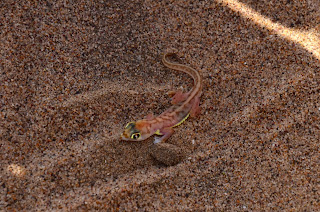Leopard, which is a very powerful animal, it can jump metres, climb trees. It stalks its prey and pounces on it, rips its throat with it's powerful jaw and teeth. They electrify the fences around the game farms to keep the leopards out, but they figure out how to jump the fences. Some can jump the fences, others use trees and climb then jump in search of more prey. At Africat, which is a foundation committed to saving the cats of Namibia (many are killed or orphaned by farmers as they kill their livestock), the leopards kill the cheetah as the cheetah do not have a lot of open plains to run and escape. Leopards stalk their prey in the bush.
Chameleon slowly making his way across the road, he forget to change his colour from the grass to the road.
Little tick which only comes out after the rain, it looks a lot prettier than our ticks
Cheetah watching the oryx. He is being rehabilitated so he and his "brothers " can be released into the wild. they have to learn how to hunt for themselves. Male cheetahs tend to hunt in groups of 3. The females are more solitary. Cheetahs are sleek and can run up to 100km/h, so they need open fields to catch their prey and escape predators. Unfortunately, there is not much open savannah left. although there is an effort to debs (a huge job)
Kudu, males, it takes 2 1/2 years for one twist to grow in their horns (they taste good too)
 |
| Warthog, the "warts" on his face help protect him during fights, the tusks are very strong and sharp. When they run, their tails stand straight up |
Impala, the "macdonalds" of Africa, they even have a little M on their bums
3 male cheetahs resting in the afternoon, notice how they are all looking in different directions, although they feel safe as we are nearby
Baboon
young bull elephant, trying to show us who is boss
elephant after the heard has crossed the road, they had young ones with them, so we kept our distance
male giraffe, you can tell by the dark hairs (not tufts) on top of their horns
male lion, guarding his female
leopard, which spend a lot of time in the trees, they often sleep there and drag their kills up the tree
 |
| cheetah waiting to be feed |












































